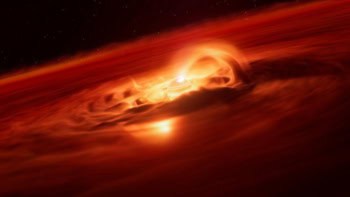
India has become the first nation to successfully put a satellite into orbit around Mars on its first attempt. Launched by the Indian Space Research Organisation (ISRO), the Mangalyaan (or “Mars craft”) Mars Orbiter began circling the red planet today. The mission is one of the cheapest interplanetary space missions ever launched, and puts India on a par with the US, Russia and the European Space Agency, which have also sent spacecraft to Mars.
Powering into orbit
“The odds were stacked against us. Of 51 missions attempted in the world, only 21 have succeeded. We have prevailed,” says Indian prime minister Narendra Modi, who was at the ISOR Telemetry, Tracking and Command Network in Bangalore today.
The craft’s main engine – a 440 Newton Liquid Apogee Motor (LAM) – which has been in standby mode for most of its 300 day journey, was awoken and tested for four minutes on Monday to tweak the spacecraft’s trajectory by 2.18 m/s and set it on course to its pre-planned orbit. This morning, the satellite used the LAM as well as eight smaller engines to put itself into orbit. It is now circling Mars in an orbit whose nearest point to Mars is at 421.7 km and farthest point is at 76,993.6 km, such that it will take Mangalyaan about 73 hours to complete one orbit.
The Mars Orbiter Mission was launched on 5 November last year from the Satish Dhawan Space Centre in Sriharikota, Andhra Pradesh, on the country’s east coast. After travelling 670 million kilometres, Mangalyaan is now set to study the surface features, morphology, mineralogy and Martian atmosphere to better understand the climate, geology, origin, evolution and sustainability of life on the planet. The team hopes that the mission will help answer one of the big questions about Mars: did the planet ever have a biosphere or even an environment in which life could have evolved?
Cheap and cheerful
Costing just $74m, Mangalyaan is the least expensive mission of its type to succeed. In comparison, NASA’s Maven mission – launched 13 days after Mangalyaan and due to arrive at Mars on Monday – cost a hefty $671m. Indeed, as the Indian prime minister pointed out in a speech, the ISRO orbiter cost less than the blockbuster $100m Hollywood film Gravity.
In the coming weeks, ISRO will put Mangalyaan through its paces, thoroughly testing it and then beginning its systematic observation of the planet. The 1350 kg craft carries five scientific payloads, including a multi-spectral camera and spectrometers, as well as a highly sensitive methane sensor to assess if gas in the Martian atmosphere is of “biological or geological origin”. For example, Mangalyaan’s Lyman-Alpha Photometer will measure the relative abundance of deuterium and hydrogen from Lyman-alpha emissions in the upper atmosphere, allowing researchers to estimate the amount of water loss to outer space. The methane sensor on board will look for traces of the methane in the atmosphere and map its sources, if any are found.



